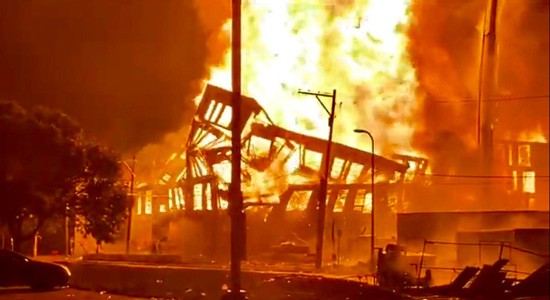Black Hatred of Authority is Not New
Robert Charles, American Renaissance, July 9, 2020

Recent attacks on firemen and police over the last few weeks are nothing new. I joined the San Francisco Fire Department in 1966. In just a few years, National Guard troops had to be assigned to several fire stations in predominantly black neighborhoods. Locals were throwing rocks, pieces of cement, and sometimes cans of food at firemen responding to fires. I forget now whether anyone even bothered to come up with an “excuse” for this behavior in the late ’60s.
In 1992, after the Los Angeles Rodney King riots, we once again came under attack from residents of black neighborhoods, this time by gunfire. As a hook and ladder company was returning to quarters after a fire, a car of young black men drove alongside the fire truck. One leaned out the passenger-side window with a pistol and shot a fireman standing on the running board. The small-caliber bullet didn’t penetrate into any internal organs; the man was back at work in a few months.
About the same the time, during a response to yet another predominantly black neighborhood, firemen came under fire. Several scrambled to safety under vehicles. One bullet skipped off the street and hit the elbow of one of our guys. After a year of surgery and rehab, he came back to the department. Like me, both those men who stopped bullets were the sons of San Francisco firemen.
Near an almost all-black ghetto where O. J. Simpson’s family and other blacks grew up in housing provided during the Second World War, an engine company was called to put out a grass fire creeping up hill towards the housing. As we dragged hoses up the dry hill, pieces of cement started landing near us. Looking up, we saw young black men laughing as they launched more concrete. Our officer said, “Screw this; we’re out of here,” and we let the grass burn up to their government-provided housing.
The men at Fire Station 17 on Shafter Avenue, in the Bay View/Hunter’s Point District, called their station “Fort Shafter” — for good reason. Blacks had come up with a novel way to hurt them. They would drive or drag old beat-up cars to the deepest part of cul-de-sacs and set them on fire. The first-responding engine company (pumper) would not attach to a hydrant. It would drive in as close as possible to the burning car and use its 400-gallon tank to put out the fire. Then the fun began.
From the rooftops, young blacks would shower the men with canned food, knowing how long it takes to turn an engine around and get out. The men were sitting targets. But they learned. When a new report of a burning car in a cul-de-sac came in, the engine driver would back down to the burning car, so the men could make a quicker escape.
Fort Shafter had another novel experience from locals they were supposed to protect. On Thanksgiving Day, an alarm came in from the farthest part of Fort Shafter’s response area. Someone had pulled a street box. The guys jumped on their rigs and sped to the box, leaving the large, manually-closed front doors open. San Francisco Fire companies had done this for decades.
It was a false alarm. When the two companies returned to quarters, they found every bit of their Thanksgiving dinner had been stolen, along with the dining-area TV set. Not long afterward, San Francisco spent a lot of money to install electronically-controlled doors in all fire stations. Ingratitude is nothing new.















